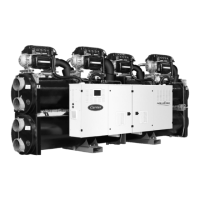
Do you have a question about the Carrier Touch Pilot Control Series and is the answer not in the manual?
Provides a broad overview of the Touch Pilot control system for water-cooled chillers.
Lists commonly used abbreviations within the manual for clarity.
Outlines general safety practices for installation, start-up, and servicing of the equipment.
Details specific safety measures related to electrical components and potential burn hazards.
Explains the role of the Touch Pilot control system as a user interface and configuration tool.
Lists the primary functions of the control system, including compressor and pump management.
Identifies the key hardware components of the Touch Pilot control system.
Describes the three modes of operation: Local, Remote, and Network.
Details the various control boards that manage unit operations and communication.
Explains the 24 VAC power supply and its distribution to the control boards.
Describes the function of light-emitting diodes (LEDs) for indicating board status.
Details the high and low pressure transducers used for measuring circuit pressures.
Describes various temperature sensors and their roles in monitoring unit operation.
Explains the function of actuators like EXV, staging valves, and flow switches.
Summarizes the various terminal block connections available for unit control.
Describes the 7-inch touchscreen interface for alarms, status, and connectivity.
Details the controller's connection ports, including RS485, Ethernet, and USB.
Explains the purpose and operation of the Home, Login, Start/Stop, and Alarm buttons.
Illustrates the menu hierarchy and navigation flow within the Touch Pilot interface.
Covers the Welcome screen, Synoptic screen, and unit start/stop procedures.
Details display settings, language, measurement systems, user login, and password.
Guides users through the Main menu, Configuration menu, and overrides.
Covers schedule setting for occupancy and web connection setup.
Lists the main menu categories and their corresponding parameter names.
Details parameters within the General Parameters menu (GENUNIT).
Provides details on all temperature sensors and their readings.
Lists all pressure sensors and their corresponding measurements.
Details the status of various input signals to the control system.
Details the status of various output signals from the control system.
Covers operating modes, pump status, miscellaneous status, and run times.
Details parameters for DC Free Cooling and Air Condenser status.
Lists and describes various setpoint values for unit operation.
Details options within the Configuration menu like General and Pump settings.
Covers Reset Configuration and User Configuration menus.
Details schedule, holiday, and date/time configuration parameters.
Lists the main categories within the Alarms menu for diagnostics.
Explains how the unit's operating type and status determine start/stop control.
Summarizes unit operation based on control type, cooling/heating selection, and status.
Describes the function of the control interlock contact for customer safety.
Explains the control point calculation and active setpoint selection in different modes.
Details how reset sources modify the active control point for capacity adjustment.
Covers ramp loading for temperature changes and compressor capacity control.
Explains how to limit unit power consumption using various methods.
Describes control of evaporator and condenser water pumps, including operation and protection.
Covers variable speed pumps, condenser valve, short cycling, leak detection, and night mode.
Explains the BACnet/IP communication protocol for building management systems.
Details dry cooler integration for heat rejection, pressure control, and free cooling.
Explains the system for controlling two linked units in a master/slave configuration.
Provides an overview of fault tracing aids and unit status display in the interface.
Covers accessing current alarms, alarm history, and resetting alarms.
Explains the option to configure e-mail notifications for new alarms or resets.
Provides a comprehensive list of alarms, their possible causes, actions, and reset types.
Recommends activating a maintenance contract for optimal operation and longevity.